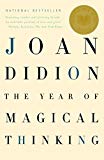
The Year of Magical Thinking is a memoir by Joan Didion which recounts her experiences in the year after her husband unexpectedly dies. Published in 2003 and now considered a classic book about the process of mourning, the book is Didion's account of grief as she re-lives her husband's life and the moment of his death over and over, wondering if anything could be different. In her famous clinical writing style, Didion analyzes her own mourning process and how she is coming to terms with loss.
The book recounts Didion's experiences of grief after Dunne's 2003 death. Days before his death, their daughter Quintana Roo Dunne Michael was hospitalized in New York with pneumonia which developed into septic shock; she was still unconscious when her father died. During 2004 Quintana was again hospitalized after a collapse and bleeding in her brain.
The narrative structure of the book follows Didion's re-living and re-analysis of her husband's death throughout the year following it, in addition to caring for Quintana. With each replay of the event, the focus on certain emotional and physical aspects of the experience shifts. Didion also incorporates medical and psychological research on grief and illness into the book.
The title of the book refers to magical thinking in the anthropological sense, thinking that if a person hopes for something enough or performs the right actions that an unavoidable event can be averted. Didion reports many instances of her own magical thinking, particularly the story in which she cannot give away Dunne's shoes, as he would need them when he returned. The experience of insanity or derangement that is part of grief is a major theme, about which Didion was unable to find a great deal of existing literature.
Didion applies the iconic reportorial detachment for which she is known to her own experience of grieving; there are few expressions of raw emotion. Through observation and analysis of changes in her own behavior and abilities, she indirectly expresses the toll her grief is taking. She is haunted by questions concerning the medical details of her husband's death, the possibility that he sensed it in advance, and how she might have made his remaining time more meaningful. Fleeting memories of events and persistent snippets of past conversations with John take on a new significance. Her daughter's continuing health problems and hospitalizations further compound and interrupt the natural course of grief.
Already have an account? Log In Now